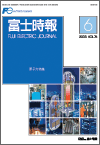Home > About Fuji Electric > Research & Development > Technical Intelligence > Fuji Electric Journal > Fuji Electric Journal
FUJI ELECTRIC JOURNAL 2003 Vol.76-No.6
 |
Nuclear Energy |
Fuji Electric's Past and Present Efforts in the Development of Nuclear Energy
Hitoshi Hayakawa, Toshiya Miki, Futoshi Okamoto
Since the inception of Japan's national nuclear energy program, Fuji Electric has built experimental facilities for various types of nuclear reactors, constructed Japan's first commercial nuclear power plant, and has continued to contribute to the development of national nuclear energy. This paper presents an overview of the specific features of Fuji Electric's technology and efforts in nuclear energy development. Fuji Electric's proprietary technologies include gas-cooled reactor technology, remote-handling and mechatronics technology, radwaste treatment technology, and superconductivity technology. Through the application of these technologies, Fuji Electric plays a major role in the development of advanced reactors such as high temperature gas-cooled reactors and fast breeder reactors, and in the fields of MOX fuel fabrication, nuclear plant decommissioning, radwaste treatment systems and fusion energy.
High Temperature Gas-cooled Reactor Technology
Yoshihiro Kiso, Keisuke Jinza, Nobumasa Tsuji
The high temperature gas-cooled reactor (HTGR) with a direct cycle helium gas turbine system has drawn attention as the next generation nuclear power plant that is closest to commercialization. Fuji Electric participated in the design, manufacture and construction of JAPCO's Tokai-1 plant, a "Colder Hall" type reactor, which was the first commercial nuclear power plant in Japan, and JAERI's high temperature engineering test reactor (HTTR), which was the first high temperature gas-cooled reactor in Japan. Fuji Electric, a pioneer of gascooled reactors, worked on the design, construction and development of these reactors. This paper provides brief descriptions of the aircooled spent fuel storage system of the HTTR, material test facilities for the HTTR, and the development of an inherently safe and highly efficient commercial HTGR power plant as examples of Fuji Electric's recent activities in the HTGR field.
Technology for Development of an FBR Plant
Yuji Hayashi, Yasushi Arai, Tetsuji Yoshimura
Fuji Electric is participating in the development of fast breeder reactors (FBRs), a Japanese national project led by the Japan Nuclear Cycle Development Institute (JNC). Fuji Electric has provided the fuel handling and storage systems, as well as the radioactive gaseous and liquid waste treatment systems for the "Joyo" and "Monju" reactors, and has been developing an innovative system aimed at the commercialization of FBRs. This paper provides an overview of Fuji Electric's activities in FBR development and also the automated remote observation system and the new refueling machine that Fuji has developed for the fuel handling system of the "Joyo" reactor.
MOX Nuclear Fuel Fabrication Technologies
Toshihiko Inui, Masanori Nagano, Hiroyuki Yamada
Under the guidance of the Japan Nuclear Cycle Development Institute (JNC), Fuji Electric has delivered many equipment and systems relating to plutonium and uranium mixed oxide (MOX) fuel fabrication. These equipment and systems seek to further enhance the reliability, economic efficiency, compactness and efficiency of fuel fabrication technology, and additionally aim to improve the capacity utilization ratio and reliability of the equipment. This paper introduces Fuji Electric's activities in the field of nuclear fuel fabrication, and also the pellet grinding and inspection equipment, and the storage and transfer systems that Fuji Electric has delivered thus far.
Radioactive Waste Management
Morio Fujisawa, Genichi Katagiri, Yoshinari Kaneko
Fuji Electric has successfully designed and manufactured radioactive waste treatment systems for the "Fugen" advanced thermal reactor (ATR) and the "Joyo" and "Monju" fast breeder reactors (FBR). A natural circulation-type evaporator was used for the treatment of liquid waste, and a high-performance charcoal adsorption system was developed for the treatment of gaseous waste. Microwaves are used in the solidification process. Over the past several years, Fuji Electric has developed an inductively coupled (IC) plasma resin volume reduction system for processing spent resin, has established a large demonstration plant in the Kawasaki Factory, and is currently performing cold testing. A pulse-wave YAG laser cutting system has also been developed for cutting metallic radioactive waste.
Technologies for Nuclear Plant Decommissioning
Masahiro Shirakawa, Takemitsu Kodama
After the commercial operation of a nuclear power plant has been shutdown, the plant enters a decommissioning phase where it is dismantled and removed. The Tokai Power Station was shutdown at the end of March 1998, followed by "Fugen" and a light water reactor. The number of decommissioned plants in Japan is likely to increase in the future. Based on experience gained from the construction and maintenance of nuclear plants, Fuji Electric has developed techniques essential for decommissioning work. This paper describes recent technologies developed in this field, such as remote dismantling techniques for the reactor core and treatment and disposal techniques for the dismantled waste.
The Development of Superconducting Equipment
Toshio Uede, Masayuki Konno, Hisaaki Hiue
Fuji Electric has been developing various types of superconducting equipment for over a quarter of a century. This paper describes the development results achieved for superconducting equipment and especially focuses on large-capacity current leads and superconducting transmission systems, the development of which is being promoted for application to the field of nuclear fusion. High temperature superconductor (HTS) is becoming the mainstream in the field of superconductivity, and the HTS floating coil and conduction-cooled HTS transformer are also introduced as recent developments for devices that utilize this technology.

